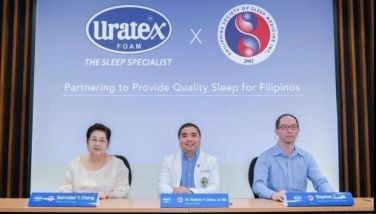Cassava a viable dextrose
January 16, 2005 | 12:00am
Dextrose from cassava?
This root crop that thrive well in the country can be used as substrate (a material from which something is made) to produce maltodextrin and glucose, two important elements in formulating dextrose, the intravenous (I.V.) fluids for medical and veterinary purposes.
The scientific headway was achieved by researchers of the UP Los Baños National Institute of Molecular Biology and Biotechnology (UPLB-BIOTECH). Involved in the researcher were Dr. Teresita Espino (BIOTECH director), Richard Tambalo, Fides Tambalo, Jack Deodato, Ma. Theresa Escosia, and Paul Arjune Olayres.
As monitored by the Philippine Council for Agriculture, Forestry and Natural Resources Research and Development (PCARRD), the BIOTECH researchers have produced two enzymes, namely: beta-amylase from a locally isolated Bacillus species (AM-1) and glucoamylase from an Asperillus niger (AN), used to produce maltodextrin and glucose from cassava starch.
Physico-chemical analysis of the dextrose monohydrate showed that the majority of the tests done by BIOTECH complied with the United States Pharmacopoiea (USP) set of standards.
Microbial and toxicological evaluations showed that the glucose solution produced was free from contaminating microorganisms, as well as oil-soluble and water-soluble toxins (poisonous substances).
Dextrose has been used mainly in food, confectionary, and beverage industries, reported PCARRD’s Clarinda Llamas-Apolinario. The baking industry, the largest consumer of dextrose, uses it as fermentable sugar and as an aid in the formation of aroma and crust color.
Moreover, dextrose is used in making tabletted products for both food and pharmaceutical industries. Medical I.V. dextrose fluid usually comes from corn starch.
The BIOTECH research won the M.S. Swaminathan Award, a recognition of outstanding research in agriculture, given by the Los Baños Science Community Foundation, Inc. (LBSCFI) during the 2004 celebration of National Science and Technology Week. – RAF
This root crop that thrive well in the country can be used as substrate (a material from which something is made) to produce maltodextrin and glucose, two important elements in formulating dextrose, the intravenous (I.V.) fluids for medical and veterinary purposes.
The scientific headway was achieved by researchers of the UP Los Baños National Institute of Molecular Biology and Biotechnology (UPLB-BIOTECH). Involved in the researcher were Dr. Teresita Espino (BIOTECH director), Richard Tambalo, Fides Tambalo, Jack Deodato, Ma. Theresa Escosia, and Paul Arjune Olayres.
As monitored by the Philippine Council for Agriculture, Forestry and Natural Resources Research and Development (PCARRD), the BIOTECH researchers have produced two enzymes, namely: beta-amylase from a locally isolated Bacillus species (AM-1) and glucoamylase from an Asperillus niger (AN), used to produce maltodextrin and glucose from cassava starch.
Physico-chemical analysis of the dextrose monohydrate showed that the majority of the tests done by BIOTECH complied with the United States Pharmacopoiea (USP) set of standards.
Microbial and toxicological evaluations showed that the glucose solution produced was free from contaminating microorganisms, as well as oil-soluble and water-soluble toxins (poisonous substances).
Dextrose has been used mainly in food, confectionary, and beverage industries, reported PCARRD’s Clarinda Llamas-Apolinario. The baking industry, the largest consumer of dextrose, uses it as fermentable sugar and as an aid in the formation of aroma and crust color.
Moreover, dextrose is used in making tabletted products for both food and pharmaceutical industries. Medical I.V. dextrose fluid usually comes from corn starch.
The BIOTECH research won the M.S. Swaminathan Award, a recognition of outstanding research in agriculture, given by the Los Baños Science Community Foundation, Inc. (LBSCFI) during the 2004 celebration of National Science and Technology Week. – RAF
BrandSpace Articles
<
>
- Latest
Latest
Latest
May 14, 2024 - 3:43pm
By Ian Laqui | May 14, 2024 - 3:43pm
April 10, 2024 - 5:12pm
By Ian Laqui | April 10, 2024 - 5:12pm
March 4, 2024 - 3:32pm
By Ian Laqui | March 4, 2024 - 3:32pm
March 4, 2024 - 2:12pm
By Kristine Daguno-Bersamina | March 4, 2024 - 2:12pm
February 17, 2024 - 2:31pm
February 17, 2024 - 2:31pm
Recommended
























